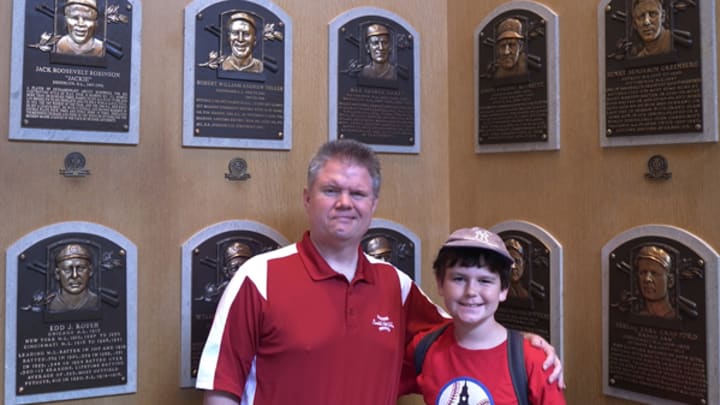A Tour of the National Baseball Hall of Fame

I recently visited Cooperstown, New York, to see a number of sites that are important to baseball and loved by fans. Naturally, one stop was the National Baseball Hall of Fame, where I had a chance to tour the Hall with Craig Muder, the Director of Communications, and speak with Jim Gates, the Librarian of the Hall of Fame.
The Baseball Hall of Fame opened on June 6, 1939. The first five members of the Hall of Fame were Babe Ruth, Walter Johnson, Honus Wagner, Ty Cobb, and Christy Matthewson. There are only 300 members of the Hall of Fame. Of those, 208 are players. The rest are managers, umpires, and executives.
The Hall of Fame is chock full of baseball artifacts, from jerseys and caps to bats and gloves. The Hall takes in about 400 new artifacts a year, with about 50 items provided by MLB and the rest donated by players, players’ families, and fans. But the Hall only displays about 10-15 percent of their artifacts at a time because they don’t have enough space to display everything. One of the most exciting parts of my visit was a program held in the Learning Center that gave kids a close-up view of Lou Gehrig artifacts, including a bat he used to hit a home run in the 1937 All-Star Game.
During my tour, I most enjoyed looking at the plaques of all the legends enshrined in the Hall and their career stats. But one really stood out: The plaque honoring Jackie Robinson looked newer than the others, especially since he was inducted into the Hall of Fame in 1962. I found out that about five years ago, with permission from Rachel Robinson, Robinson’s widow, the Hall added information about how Robinson was the first black man ever to play in the bigs. As per his request, the original plaque only mentioned his highlights on the field. (Roberto Clemente’s plaque has also been altered to read Roberto Clemente Walker, his actual name, instead of Roberto Walker Clemente.)
The Hall also has different exhibits that take fans inside the game. One of the newest is about baseball scouts. It was developed with SABR and has artifacts and historical information to show how important scouts are to the game. My favorite part was a scouting report on Dennis Eckersley. Right above the report was a video of Kirk Gibson’s dramatic walk-off home run off Eck in the 1988 World Series that he hit with an injured leg.
I asked Mr. Muder if the Hall of Fame had considered including sabermetrics on future plaques along with the traditional stats you see now, like homers, RBIs, wins, and saves. He said they would figure that out when the time came.
But different people connected to the Hall of Fame have different opinions about the use of stats on the plaques. Jim Gates, the Librarian, feels that stats shouldn’t be listed on the plaques as much as they are. The player’s history is more important than numbers. “I am OK with some numbers appearing with plaques, but they should not be the centerpiece since there are so many interesting things we can write about the inductees,” he told me.
I certainly learned a lot during my visit to the Hall, as well as my trip to Cooperstown. If you have been to visit Cooperstown, please post a comment about your favorite Hall of Fame memory or other Cooperstown experience!
Max Mannis is an 11-year-old special correspondent for sikids.com and a member of SABR. Catch his posts on advanced baseball statistics. To learn more about SABR and to join, visit www.sabr.org.

